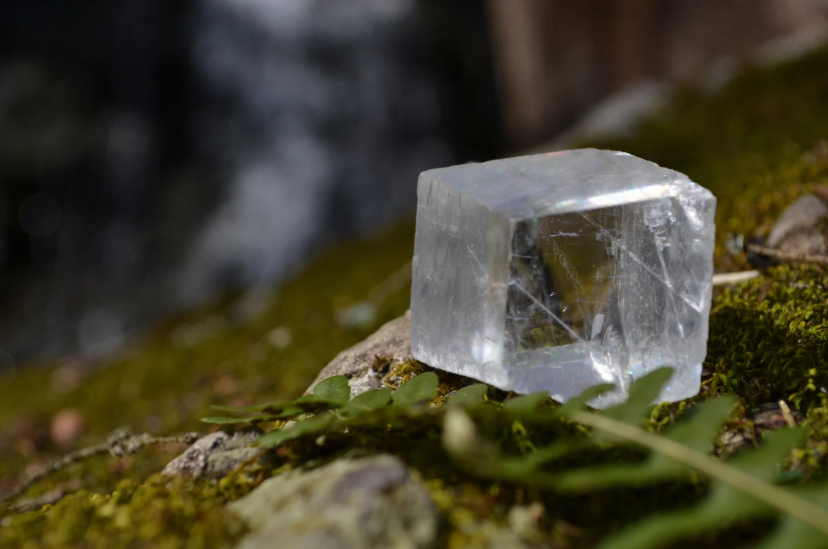
Iceland Spar, Vikings' Sunstone
Share
Medieval Icelandic texts speak of a “sunstone,” or a mineral by which one could locate the precise position of the sun in an overcast sky. More than 1,000 years ago, the Vikings sailed with nothing but this mysterious stone to help them navigate the clouds, fog, and lengthy summertime twilights of the North. The exact type of mineral they used remained unknown for centuries. However, many researchers now believe that the Vikings’ magical “sunstones” were actually Iceland spar.

Iceland spar is also known as optical calcite or, formerly, Iceland crystal. (In Icelandic, it is silfurberg, which translates to “silver-rock.”) It is a variety of calcium carbonate that crystallizes in the trigonal system, and is usually colorless but can sometimes be yellow or golden.
Yet Iceland spar is truly remarkable because of its optical properties. It exhibits birefringence, meaning a ray of light passing through the crystal will split into two rays of mutually perpendicular polarization. Because of this double refraction, objects viewed through the crystal will appear to be doubled. Iceland spar can also produce vibrant colors when placed under polarized light, a phenomenon known as the “Becke line,” which itself can help determine other minerals’ refractive indexes. Another property of Iceland spar is that it is optically active. Due to the crystal’s asymmetrical atomic arrangement, it can rotate the plane of polarization of light passing through it.
The optical properties of Iceland spar have lent the crystal historical significance in both science and navigation. In scientific research, it was a major asset in understanding light as a wave. Christiaan Huygens, famous Dutch mathematician and physicist of the 17th century, used its optical properties to support his wave theory of light (which stood in contrast to Sir Isaac Newton’s corpuscular theory). Iceland spar’s double refraction also aided in the development of polarized light microscopy, and the crystal has long been used in optical instruments across many disciplines.

What, then, of the Vikings? Texts like Rauðúlfs þáttr, Hrafns saga Sveinbjarnarsonar, and various monastic inventories of the 14th and 15th centuries refer to a “sunstone” providing crucial aid in navigation on the Northern seas. According to these texts, one could hold up a “sunstone” and note where it emitted, reflected, or transmitted light. In Thorsteinn Vilhjalmsson’s translation of Rauðúlfs þáttr, the use of the sunstone is described thus:
“The weather was thick and snowy as Sigurður had predicted. Then the king summoned Sigurður and Dagur (Rauðúlfur’s sons) to him. The king made people look out and they could nowhere see a clear sky. Then he asked Sigurður to tell where the sun was at that time. He gave a clear assertion. Then the king made them fetch the solar stone and held it up and saw where light radiated from the stone and thus directly verified Sigurður’s prediction.”
Rarely are legend and lore replicated by science. Yet a research team led by Guy Ropars, a physicist at the University of Rennes in France, sought to understand how the mysterious “sunstone” could have worked. They made sure to choose a completely overcast day for their experiment. They placed a piece of Iceland spar into a wooden apparatus that beamed light from the sky onto the crystal. This light passed through the crystal and subsequently through a tiny hole in the device, projecting a double image onto a flat surface. Over the course of the day, when light passed from the sky and through the calcite, Ropars’ team would change the stone’s orientation until the projections from the split beams were equally bright. They found that the double refraction of the stone allowed them to accurately predict the sun’s precise trajectory.

Science, yet again, unlocks history. Today, Iceland spar is widely believed to be the magical “sunstone” mentioned again and again in ancient Scandinavian legend. I find a profound sense of poetry in the use of a simple mineral to navigate the treacherous Northern seas. I picture a “ring-whorled prow” riding “ice-clad, outbound,” as in the epic poem Beowulf, but with one gleaming crystal clutched in the hand of the captain. Iceland spar is therefore a stone that hastens back to histories so old they have become myth. Hold a piece and concentrate. You might just smell salt on the air.
~~~
by Amber N. 2025
